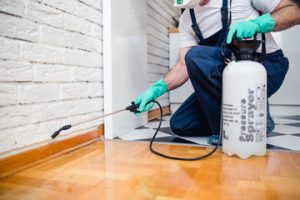Pest Control Trophy Club TX is the regulation and management of species that are considered to be harmful to human activities and natural ecosystems. It is a complex field that involves many methods and tools.

Rodents and insects like flies, cockroaches, ants, and moths pose serious health risks to food products. They can spread bacteria and introduce contaminants that affect the safety of food items.
In pest control, accurate identification is essential. Many pests look different at different stages in their life cycle and as they grow. For example, a weed seedling often looks very different than the mature plant. Accurate identification allows pest professionals to target management tactics to the most vulnerable stage of the pest’s life cycle, and to correctly match the problem with an appropriate control measure.
Incorrect identification can be frustrating, but it can also lead to inappropriate or ineffective controls. Incorrectly identifying pests can also prevent the proper use of beneficial insects or other strategies that help to manage populations. In addition, it can lead to costly overtreatment of a problem.
The most common pests in cultural heritage settings are insects, such as cockroaches and ants. These pests can damage library materials by chewing or excreting on them. Occasionally, these pests may enter buildings in search of food, water or shelter. Occasional invaders do not breed indoors and are considered nuisance pests. However, their presence inside a building can be a sign of structural weakness or a cultural issue, such as employees propping open doors.
Other types of pests that can be problematic in libraries include flying insects (moths, flies, bees, wasps, hornets and yellow jackets) and jumping pests (spiders and fleas). Some of these pests sting or bite, while others spread diseases, including West Nile virus and malaria.
There are a variety of methods to keep pests from entering or breeding in libraries. Physical techniques include mouse traps, fly screens, and ultrasonic repellers. Biological methods involve using natural predators or pathogens to control insect pests, such as ladybugs that feed on aphids and bacteria that kill mosquito larvae. Other preventive measures include regularly emptying trash, storing food in sealed containers, and repairing leaks.
Changing the environment can also deter pests. Eliminating weeds around buildings can reduce food sources for pests. Keeping compost bins and garbage cans tightly closed and cleaned can help to prevent rodent infestations. Air conditioning filters should be kept clean to prevent moisture buildup. Lastly, the outside of the building should be checked frequently for holes that could be used to enter and a caulk seal can be applied where necessary.
Pest Prevention
The best way to avoid pest infestations is through preventive methods. These are economical and environmentally responsible approaches that reduce conditions that promote pest establishment. These include frequently cleaning areas where pests are likely to be found, sealing cracks and crevices, removing outdoor debris and maintaining proper sanitation. Pest control programs can also help by delivering targeted treatments to specific problem areas, or through the use of repellants and deterrents.
Pests enter living and work spaces because they are seeking food or shelter. This is why building occupants play such a critical role in pest prevention. Doors left open or screens removed provide ready access for pests to enter. Pests are often carried into living and working spaces inside luggage, potted plants or other articles brought in from infested areas. Poor sanitation practices, such as failing to store food in tightly sealed containers or disposing of trash in pest-resistant receptacles, are additional factors that lead to pest problems.
Using Integrated Pest Management (IPM) methods to prevent and monitor pests, along with proper maintenance and cleaning practices, is the most effective approach to pest control. Having pests identified correctly is also essential, as this allows the proper use of the least hazardous pesticides to effectively control pests.
Proper identification of pests enables us to better understand their life cycles, habits and needs, as well as how they interact with people, plants, and the environment. It is only through this understanding that we can develop control strategies that are appropriate and effective.
When a pest is first noticed, it is important to immediately notify your Pest Control Operator. Providing the PCO with a detailed report including the date and time of the sighting, as well as where the pests were found will ensure the most effective treatment. In addition, it is always a good idea to keep the PCO informed of any changes in normal pest activity, such as increased numbers or unusual patterns.
Once the proper steps are taken to control a pest, it is important to evaluate your efforts and make any necessary adjustments. For instance, if the pest is causing a health risk or damage, it may be necessary to re-evaluate your tolerance levels and increase treatment intensity.
Pesticides
A pesticide is a chemical substance that kills or repels a plant or animal that is considered to be a nuisance or a threat to health, safety or the environment. It is used to protect crops, plants or other organisms from harmful agents (such as diseases, insects, weeds and rodents). Chemical pesticides include herbicides for controlling unwanted vegetation, insecticides for killing or controlling insects, fungicides for destroying fungi and disinfectants for preventing and controlling diseases.
Pesticides are typically classified according to the type of organism they control, or target, and their level of toxicity. They may also contain additional ingredients, called co-formulants or safeners, that help to reduce the risk of harm to non-target organisms. The use of pesticides must be balanced with other methods of pest management, including monitoring and non-chemical methods such as cultural controls.
Before using any pesticide, always read and follow the label directions carefully. Wear proper protective equipment and follow all other safety precautions. Wearing rubber gloves and a face mask can help to reduce the exposure to potentially harmful chemicals. Avoid spraying when the weather is windy or rainy, as the drift of the pesticide could affect other areas or people. Keep pesticides out of reach of children and pets, and store them in a secure area. If possible, use organic or natural pesticides, such as horticultural soaps, which are less toxic than chemical alternatives.
The best pest control is preventing the problem before it begins. Inspect the exterior of your home regularly for entry points and seal them with caulk or steel wool. Remove debris, trash and wood piles that can provide hiding places for pests. Keep the yard clean, keeping grass and weeds cut and eliminating standing water where mosquitoes can breed.
In addition, store food in airtight containers to prevent pests from accessing it. Vacuum and sweep often to remove food crumbs and other materials that can attract pests, and dispose of waste in garbage cans with tight-fitting lids. Regularly empty and clean the garage, basement, attic and other storage areas to remove clutter that can provide nesting sites for pests.
Termite Control
A termite infestation is dangerous and costly, causing extensive damage to the wood in homes and commercial structures. While most termite control methods are reactive, addressing existing colonies, preventive measures can help stop the insects before they gain a foothold. Unlike control products, prevention methods are not harmful to people or pets, minimizing the need for invasive treatments inside living spaces.
Termites are social insects that share food and water with each other. To keep their nests and tunnels moist, they construct mud tubes, which are often found along foundation walls and in crawl spaces. Tiny holes in wood, surrounded by frass (termite droppings), can also indicate the presence of a termite infestation.
Traditional treatment methods include soil barriers and termite baiting systems. Soil barriers involve trenching and injecting pesticide into the soil around a structure’s foundation, creating an unbroken barrier that termites cannot cross. A more targeted approach, baiting systems consist of pre-baited devices that are attached to the surface of wood in areas where termites feed (foundation walls, floor joists and sub-floor). When the device is accessed by foraging termites, they ingest the pesticide, contact other members of their colony with it and spread it to the entire population through habitual grooming.
Some companies offer alternative biological termite control methods, such as nematodes and fungi that are lethal to the insects without harming other ecosystem components. These methods are gaining traction as they present a low-toxicity alternative to product treatments and align with the growing demand for environmentally friendly pest control solutions.
Other specialized techniques include fumigation and heat treatments. Fumigation, or tent treatment, is a full-structure gas treatment used for severe termite infestations, penetrating all parts of the structure to kill the insects. This is one of the most effective treatments, but it can be disruptive and require temporary relocation. Heat treatments use electricity or microwaves to raise the temperature of wooden structures to a level that is fatal to termites, but can be limited to surface-level applications and may not penetrate deep wood elements or hidden termite galleries.
Whether you need a reactive or proactive approach to termite control, a professional pest control company can advise you on the best options for your home or business. By working with an experienced team, you can enjoy peace of mind knowing your property is protected from termites and the significant damage they cause.



